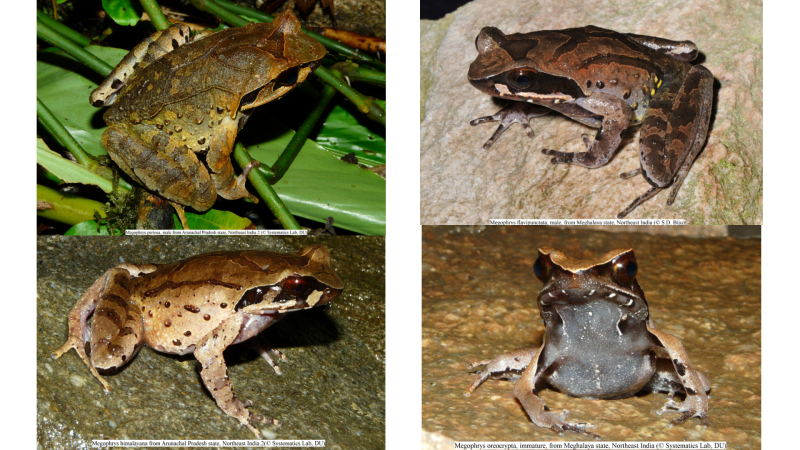
The northeast region of India is a remote, pristine and unexplored part of the country. Recent research expeditions in the area, which is a part of the Himalayas and the Indo-Burma biodiversity hotspot, have revealed a host of discoveries of new plants and animals—from India’s first new bird species in a decade to the first new macaque species in the world in over 100 years. Several new species of fish, reptiles, insects and amphibians have also been reported from here in recent years.
A recent addition to this enchanting list is the discovery of four new species of horned frogs in the Himalayan forests. Horned frogs are named so because of the fleshy, horn-like projection on their upper eyelids. In a recent study, published in the journal Zootaxa, a team of Irish and Indian biologists from the University College Dublin (UCD), Ireland, the Natural History Museum (NHM), UK, and the University of Delhi (DU), India, have provided detailed descriptions of these newly discovered frogs.
The four new species, which take the number of horned frogs from Northeast India to 15, are named the Himalayan horned frog (Megophrys himalayana), the Garo white-lipped horned frog (Megophrys oreocrypta), the Yellow-spotted white-lipped horned frog (Megophrys flavipunctata), and the Giant Himalayan horned frog (Megophrys periosa), which grows to over 11 cm long and is the largest horned frog from this region. The study was funded by fellowships from Irish Research Council, Council of Scientific & Industrial Research (CSIR), Rufford Foundation Small Grant, and the Department of Science and Technology (DST).
This discovery is the result of fourteen years of research, including seven years of dedicated fieldwork in the remote forests of Northeast India—one of the wettest and most difficult terrains in the world.
“We only ever see horned frogs at night in the forest, and they are generally tough to find because they occur in low numbers. Working in the forest at night in the remote jungles of Northeast India can be dangerous due to problems of insurgency and the likelihood of encountering wild animals. But the hardship is worthwhile when we find new species”, says Dr Rachunliu Gaiduwan Kamei, formerly of DU, who is an author of this study.
The researchers were investigating a group of six closely related species of horned frogs whose identities have been subject to over 150 years of confusion when they chanced upon this discovery. Earlier, they were all considered to represent one species called the Jerdon’s white-lipped frog (Megophrys major) that ranged from Northeast India to southern Vietnam. After analysing the genetic information, the researchers discovered that several species, which superficially look quite similar, were hidden under this name.
“The discovery of relatively large new species of frogs is not very common these days. This study highlights how an animal that scientists thought they knew well for the past 150 years can surprise us when we take a closer look at them”, remarks Dr Stephen Mahony, the lead author of the study, currently from UCD and the NHM. There is not much known about these new species yet, except that they are found in different habitats. “Nobody has recorded what their mating call sounds like, or where they go outside of the breeding season, how long they live, or what they eat”, adds Dr Mahony.
Individuals of all the five frog species (the four new species and M. major, which they were originally confused with) look very similar to each other, but clearly differ in their DNA. The researchers recognise that the new species are members of the Megophrys major species complex—a term used to describe a group of species that look very similar but are genetically distinct and geographically separated from one another. “Our previous work demonstrated that these new species have each been evolving separately for millions of years. That they all look similar means that they may simply have evolved the perfect body design to match their lifestyle and environment”, explains Dr Mahony about the reasons behind the similarity in their appearance.
The study emphasises the need to explore under-studied regions like Northeast India, where several such new species could be hiding in plain sight.
“Northeast India is rich in amphibian diversity, but despite being part of two globally recognised biodiversity hotspots, this region is neglected as compared to the Western Ghats hotspot in southern India. Our discovery highlights the need to carry out systematic research in Northeast India to fully understand and conserve its unique frog fauna”, signs off Dr S.D. Biju, from the University of Delhi, who is also an author of the study.
